Disruption of Rab8a and Rab11a causes formation of basolateral microvilli in neonatal enteropathy
- PMID: 28596241
- PMCID: PMC5558269
- DOI: 10.1242/jcs.201897
Disruption of Rab8a and Rab11a causes formation of basolateral microvilli in neonatal enteropathy
Erratum in
-
Correction: Disruption of Rab8a and Rab11a causes formation of basolateral microvilli in neonatal enteropathy (doi: 10.1242/jcs.201897).J Cell Sci. 2018 Sep 17;131(18):jcs224535. doi: 10.1242/jcs.224535. J Cell Sci. 2018. PMID: 30224429 Free PMC article. No abstract available.
Abstract
Misplaced formation of microvilli to basolateral domains and intracellular inclusions in enterocytes are pathognomonic features in congenital enteropathy associated with mutation of the apical plasma membrane receptor syntaxin 3 (STX3). Although the demonstrated binding of Myo5b to the Rab8a and Rab11a small GTPases in vitro implicates cytoskeleton-dependent membrane sorting, the mechanisms underlying the microvillar location defect remain unclear. By selective or combinatory disruption of Rab8a and Rab11a membrane traffic in vivo, we demonstrate that transport of distinct cargo to the apical brush border rely on either individual or both Rab regulators, whereas certain basolateral cargos are redundantly transported by both factors. Enterocyte-specific Rab8a and Rab11a double-knockout mouse neonates showed immediate postnatal lethality and more severe enteropathy than single knockouts, with extensive formation of microvilli along basolateral surfaces. Notably, following an inducible Rab11a deletion from neonatal enterocytes, basolateral microvilli were induced within 3 days. These data identify a potentially important and distinct mechanism for a characteristic microvillus defect exhibited by enterocytes of patients with neonatal enteropathy.
Keywords: Enterocyte; Microvillus formation; Neonatal enteropathy; Rab11a; Rab8a.
© 2017. Published by The Company of Biologists Ltd.
Conflict of interest statement
Competing interestsThe authors declare no competing or financial interests.
Figures
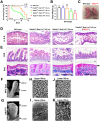
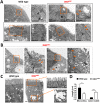
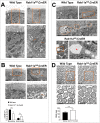
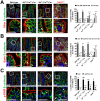
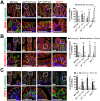
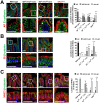
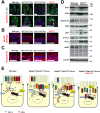
Similar articles
-
Myosin Vb uncoupling from RAB8A and RAB11A elicits microvillus inclusion disease.J Clin Invest. 2014 Jul;124(7):2947-62. doi: 10.1172/JCI71651. Epub 2014 Jun 2. J Clin Invest. 2014. PMID: 24892806 Free PMC article.
-
Abnormal Rab11-Rab8-vesicles cluster in enterocytes of patients with microvillus inclusion disease.Traffic. 2017 Jul;18(7):453-464. doi: 10.1111/tra.12486. Epub 2017 May 17. Traffic. 2017. PMID: 28407399 Free PMC article.
-
Rab11a regulates syntaxin 3 localization and microvillus assembly in enterocytes.J Cell Sci. 2015 Apr 15;128(8):1617-26. doi: 10.1242/jcs.163303. Epub 2015 Feb 11. J Cell Sci. 2015. PMID: 25673875 Free PMC article.
-
Trafficking Ion Transporters to the Apical Membrane of Polarized Intestinal Enterocytes.Cold Spring Harb Perspect Biol. 2018 Jan 2;10(1):a027979. doi: 10.1101/cshperspect.a027979. Cold Spring Harb Perspect Biol. 2018. PMID: 28264818 Free PMC article. Review.
-
RAB and RHO GTPases regulate intestinal crypt cell homeostasis and enterocyte function.Small GTPases. 2016 Apr 2;7(2):59-64. doi: 10.1080/21541248.2016.1159274. Epub 2016 May 4. Small GTPases. 2016. PMID: 27142493 Free PMC article. Review.
Cited by
-
Primary cilia control cell alignment and patterning in bone development via ceramide-PKCζ-β-catenin signaling.Commun Biol. 2020 Jan 27;3(1):45. doi: 10.1038/s42003-020-0767-x. Commun Biol. 2020. PMID: 31988398 Free PMC article.
-
RAB11A and RAB11B control mitotic spindle function in intestinal epithelial progenitor cells.EMBO Rep. 2023 Sep 6;24(9):e56240. doi: 10.15252/embr.202256240. Epub 2023 Jul 10. EMBO Rep. 2023. PMID: 37424454 Free PMC article.
-
A V0-ATPase-dependent apical trafficking pathway maintains the polarity of the intestinal absorptive membrane.Development. 2019 Jun 5;146(11):dev174508. doi: 10.1242/dev.174508. Development. 2019. PMID: 31110027 Free PMC article.
-
Rab11a Is Essential for the Development and Integrity of the Stereocilia and Kinocilia in the Mammalian Organ of Corti.eNeuro. 2023 Jun 5;10(6):ENEURO.0420-22.2023. doi: 10.1523/ENEURO.0420-22.2023. Print 2023 Jun. eNeuro. 2023. PMID: 37225424 Free PMC article.
-
Rab21 in enterocytes participates in intestinal epithelium maintenance.Mol Biol Cell. 2022 Apr 1;33(4):ar32. doi: 10.1091/mbc.E21-03-0139. Epub 2022 Feb 16. Mol Biol Cell. 2022. PMID: 35171715 Free PMC article.
References
-
- Aumailley M., Pesch M., Tunggal L., Gaill F. and Fassler R. (2000). Altered synthesis of laminin 1 and absence of basement membrane component deposition in (beta)1 integrin-deficient embryoid bodies. J. Cell Sci. 113, 259-268. - PubMed
MeSH terms
Substances
Grants and funding
LinkOut - more resources
Full Text Sources
Other Literature Sources
Medical
Molecular Biology Databases

